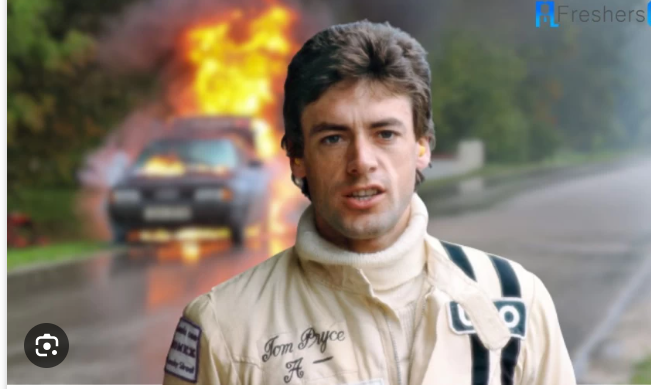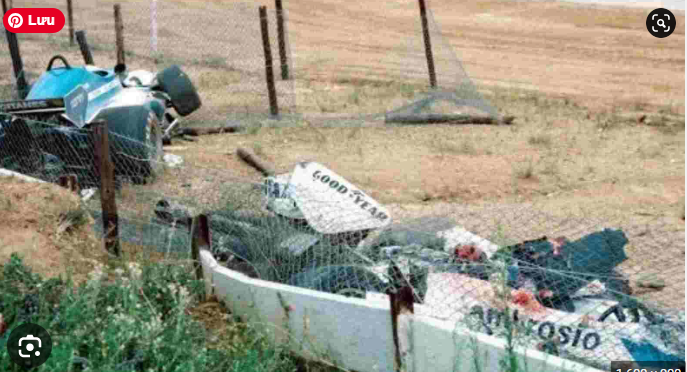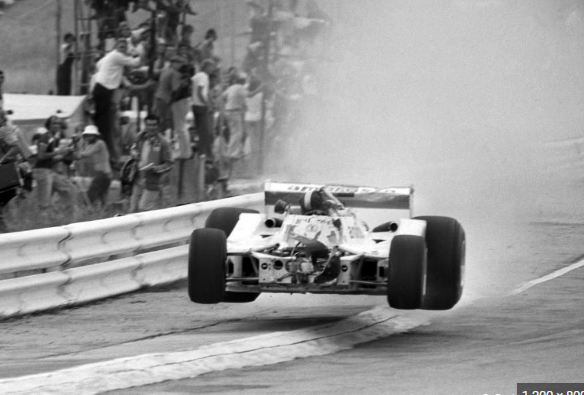In the high-speed world of Formula 1, where the thrill of velocity converges with the pursuit of glory, there exists a chilling reminder of the sport’s unforgiving nature—a video that transcends time to unveil a moment of harrowing tragedy. This video, the 1977 African Grand Prix crash video footage, is no ordinary recording; it’s a visceral journey into the heart of Formula 1’s past, a relic that dares us to look, to remember, and to question. It’s a window into a fateful day at Kyalami Circuit in South Africa, where a promising driver named Tom Pryce met a destiny that would forever haunt the sport. Join us as we unravel the gripping tale behind this video, a tale of fire, collision, and an ethical dilemma that continues to shape the legacy of Formula 1.

I. What Happened in the 1977 African Grand Prix Crash?
The 1977 African Grand Prix, held at the Kyalami circuit in South Africa, witnessed a tragic and fatal accident involving Welsh racing driver Tom Pryce. The crash occurred during the race on March 5, 1977, and here are the key details of what happened:
Race Context: The 1977 South African Grand Prix was part of the Formula One World Championship. It was one of the premier events in motorsports, attracting top drivers from around the world.
Accident Sequence: During the race, there was an incident where the Shadow racing car of Italian driver Renzo Zorzi caught fire and came to a halt on the track. Two marshals rushed onto the track to extinguish the flames.
Tom Pryce’s Involvement: Tom Pryce, driving for the Shadow team, was approaching the scene at high speed. The first marshal managed to cross the track safely, but Pryce’s car struck the second marshal, Frederik Jansen van Vuuren.
Fatal Consequences: Tragically, van Vuuren was fatally injured in the collision. His injuries were caused in part by a fire extinguisher he was carrying, which struck Pryce’s head, causing severe head injuries. Pryce’s car eventually crashed into a catch fence at the conclusion of the pit straight.
Outcome: Both Tom Pryce and marshal Frederik Jansen van Vuuren lost their lives in the accident. The race was red-flagged, and it had a profound impact on the motorsport community and safety measures in Formula 1.
The incident was a stark reminder of the dangers involved in motor racing and the need for improved safety measures. It serves as a cautionary tale about the risks faced by both drivers and track personnel in the high-speed world of Formula 1. The video footage of the crash has since become a part of motorsport history and continues to be a topic of discussion and reflection in the racing community.

II. Tom Pryce and the 1977 African Grand Prix
The world of motorsports is no stranger to triumphs, tragedies, and tales of remarkable individuals who pushed the limits of human skill and courage. Among those stories is the tragic saga of Tom Pryce, a promising Welsh racing driver whose journey through the high-speed world of Formula 1 met a heartbreaking end at the 1977 African Grand Prix. In this article, we delve deep into the life and career of Tom Pryce and the fateful race that forever etched his name into the annals of motorsport history.
Tom Pryce: A Promising Racer
Tom Pryce’s path to Formula 1 was not one of privilege or inherited fame. Born in Ruthin, Wales, in 1949, Pryce’s early years were marked by his passion for racing. His humble beginnings in karting and lower-tier racing categories showcased his raw talent and unwavering determination.
As Pryce honed his skills on the racetrack, he caught the attention of the motorsport community with his impressive performances. His talent was undeniable, and it wasn’t long before he was recognized as a rising star in the world of motorsports.
In 1974, Pryce made his debut in Formula 1, driving for the Token Racing Team. While his initial foray into the pinnacle of motorsports was modest, it was a stepping stone to greater opportunities. The following year, Pryce secured a spot with the Shadow Racing Team, a move that would define his career.
The Fateful Race
The 1977 African Grand Prix, held at the legendary Kyalami circuit in South Africa, was the setting for the tragedy that would unfold. The race itself was part of the Formula One World Championship, attracting the world’s top drivers, including the likes of Niki Lauda, James Hunt, and Mario Andretti.
As the race commenced, tensions ran high. The Kyalami circuit was known for its challenging layout, featuring high-speed straights and demanding corners. Pryce, with his Shadow-Ford car, was eager to make his mark in what promised to be a fiercely competitive race.
However, fate had other plans. During the race, a terrifying incident occurred that would change the course of motorsport history. Italian driver Renzo Zorzi’s car, driving for the Shadow team, burst into flames on the track. It was a perilous situation that required immediate attention.
Two brave marshals rushed onto the track to extinguish the flames and assist Zorzi. The first marshal managed to cross the track safely, but as Tom Pryce approached the scene at a blistering pace, tragedy struck. His car collided with the second marshal, Frederik Jansen van Vuuren, with devastating consequences.
Van Vuuren, carrying a fire extinguisher, was struck by Pryce’s car and suffered fatal injuries. Pryce’s car continued its trajectory, eventually crashing into a catch fence at the pit straight. The impact was catastrophic, and both Tom Pryce and marshal Frederik Jansen van Vuuren lost their lives in the tragic accident.
The 1977 African Grand Prix stands as a stark reminder of the inherent dangers in the world of Formula 1 and motorsports. Tom Pryce, a promising talent with a bright future, became a symbol of the risks faced by drivers and track personnel in the pursuit of speed and glory.
The tragedy also played a significant role in highlighting the need for enhanced safety measures in motorsports. In the wake of the accident, Formula 1 and other racing organizations intensified their efforts to improve safety protocols, ultimately saving countless lives in the years that followed.
Tom Pryce’s legacy lives on in the memories of motorsport enthusiasts and the enduring lessons learned from that fateful day at Kyalami. His story serves as a poignant reminder of the fine line between triumph and tragedy in the world of racing.
III. The Shocking 1977 African Grand Prix Crash Video
In the world of motorsports, moments of triumph and tragedy are often intertwined, leaving an indelible mark on the sport’s history and the collective memory of its fans. One such moment that continues to resonate with racing enthusiasts is the 1977 African Grand Prix crash involving Tom Pryce. However, what makes this incident even more haunting is the existence of a shocking video that captured the tragedy in real-time. In this article, we delve into the profound significance of the 1977 African Grand Prix crash video and examine the emotional aftermath that rippled through the public and the motorsport community.
Capturing Tragedy: The 1977 African Grand Prix Crash Video
The power of video as a medium for capturing events, both joyous and heartbreaking, cannot be overstated. In the case of the 1977 African Grand Prix, this power was harnessed to document a moment that would forever change the perception of Formula 1 racing.
The video, shot by a spectator or an official cameraperson, provides a chilling, first-hand account of the events that unfolded on that fateful day. It vividly captures the race, the fire that engulfed Renzo Zorzi’s car, and the subsequent collision between Tom Pryce’s vehicle and marshal Frederik Jansen van Vuuren.
The Impact and Aftermath
Immediate Shock: When the video of the 1977 African Grand Prix crash surfaced, it sent shockwaves through the motorsport community and beyond. Viewers were confronted with the brutal reality of the sport they loved, where moments of exhilaration could swiftly transform into scenes of horror.
Public Reaction: The video’s release to the public sparked intense debate and discussions. It led to questions about the safety of Formula 1 racing and whether spectators should be allowed to view such graphic content. Some argued that it was essential to show the risks involved in motorsports, while others believed it was too distressing for public consumption.
Safety Concerns: The video served as a catalyst for renewed attention to safety in Formula 1. The shocking images of the 1977 crash prompted the racing community to reevaluate safety protocols and implement stricter measures to protect drivers, track personnel, and spectators.
Legacy of the Video: The video has had a lasting impact on motorsport safety. It is often used in training sessions for race officials and drivers to emphasize the importance of adhering to safety guidelines. It remains a somber reminder of the sacrifices made in the pursuit of speed and glory.
The existence of the 1977 African Grand Prix crash video is a testament to the power of visual storytelling and its ability to convey the raw emotions of the moment. It serves as a poignant reminder of the inherent risks in motorsport and the importance of constantly striving for enhanced safety measures.
The public’s reaction to the video underscores the delicate balance between transparency and sensitivity when it comes to sharing such content. While it has been a catalyst for positive change in motorsport safety, it also forces us to grapple with the uncomfortable realities of a sport that often teeters on the edge of danger.
As we reflect on the impact of this shocking video, we honor the memory of Tom Pryce, marshal Frederik Jansen van Vuuren, and all those who have sacrificed for the pursuit of excellence in Formula 1. Their legacy reminds us that, in the world of motorsports, safety is paramount, and the lessons of the past must guide us toward a safer future.
IV. Parallels with Modern F1: The 2022 British Grand Prix Incident

The world of Formula 1 is a realm where history and modernity intersect, where the echoes of past tragedies resonate through the present. In the annals of motorsport, one such tragic incident is the 1977 African Grand Prix crash, a haunting event captured in a shocking video that continues to serve as a stark reminder of the sport’s inherent risks. But what happens when history seems to repeat itself? In this article, we explore the remarkable parallels between the 1977 African Grand Prix and the 2022 British Grand Prix, where an attempted track invasion uncannily mirrored the dangers of the past.
Track Invasion Attempt at the 2022 British Grand Prix
In July 2022, the world turned its attention to Silverstone, the iconic circuit in Northamptonshire, England, for the British Grand Prix. Formula 1 fans eagerly awaited the showdown between racing titans, with Max Verstappen and Lewis Hamilton locked in a fierce championship battle. However, as the race day approached, a different narrative began to unfold.
On race day, a group of protesters attempted to invade the track at Silverstone, momentarily disrupting the proceedings. Their aim was to draw attention to environmental and social issues, but their chosen method was both audacious and dangerous.
The protesters, who appeared to breach security barriers, posed a real threat not only to themselves but also to the drivers and track personnel. The potential consequences of such an intrusion were clear: a high-speed collision between a racing car and a protester could have been catastrophic, mirroring the tragedy of the 1977 African Grand Prix in which Tom Pryce lost his life.
Connecting the Past and Present
The parallels between the 1977 African Grand Prix and the 2022 British Grand Prix are eerily striking:
Dangerous Intrusions: In both cases, individuals attempted to breach the safety barriers and enter the live racing circuit during a Grand Prix. This act of recklessness placed not only their lives but also those of the drivers, marshals, and spectators at risk.
High-Speed Blind Spots: The layout of racing circuits often includes sections where drivers have limited visibility due to high-speed corners or elevation changes. In such areas, sudden intrusions can be especially perilous, as drivers have little time to react.
Fatal Consequences: Tragically, both incidents resulted in fatalities. In 1977, Tom Pryce and marshal Frederik Jansen van Vuuren lost their lives. While the 2022 British Grand Prix protesters were fortunate to escape unharmed, the potential for a catastrophic outcome was very real.
These parallels underscore the gravity of the 2022 British Grand Prix incident and serve as a stark reminder of the importance of safety in motorsports. While Formula 1 has made significant strides in enhancing safety measures since 1977, the events at Silverstone illustrate that the specter of danger still looms.
The 2022 British Grand Prix incident serves as a poignant reflection of the past and a somber reminder of the risks involved in motorsport. It reinforces the notion that safety must always be paramount, even as the sport continues to push the boundaries of speed and innovation.
As fans and stakeholders in Formula 1, we must acknowledge the lessons of history and continue to work towards a safer future for the sport we love. The parallels between the 1977 African Grand Prix and the 2022 British Grand Prix are not mere coincidences but powerful reminders that the past should guide our commitment to safety in the present and beyond.

V. Lessons in Safety: Past and Present
The history of Formula 1 is a tapestry woven with moments of exhilaration, triumph, and heartbreak. Among its threads are the stories of fearless drivers who pushed the limits of speed and skill. But intertwined with these tales is the ever-present specter of danger. In this article, we embark on a journey through time, exploring the lessons in safety learned from the past and how they continue to shape the world of Formula 1 today.
Safety Measures in 1977
The 1977 African Grand Prix stands as a stark reminder of the safety challenges that once plagued Formula 1. During that era, safety protocols were vastly different from what we see in the sport today:
Limited Safety Gear: Drivers in 1977 wore minimal safety gear compared to modern standards. Helmets were basic, and the level of protection they provided was rudimentary when compared to today’s high-tech helmets with advanced materials and designs.
Track Barriers: Circuit safety was also deficient. The barriers surrounding the tracks were often less effective at absorbing impact, increasing the risk of severe crashes.
Marshals and Safety Personnel: The presence of marshals on the track, although essential for race safety, was not always backed by rigorous training and standardized safety procedures.
Medical Facilities: Medical facilities and response times were not up to par. In the event of an accident, the availability of qualified medical personnel and equipment was limited.
Limited Driver Visibility: High-speed sections of tracks frequently rendered drivers with limited visibility, making it challenging to react swiftly to unexpected obstacles or incidents on the track.
Evolution of Safety in F1
Thankfully, the tragic events of the 1977 African Grand Prix served as a catalyst for change within Formula 1. Over the years, the sport has made remarkable strides in enhancing safety measures:
Advanced Safety Gear: Today’s drivers benefit from cutting-edge safety gear, including helmets designed to withstand incredible impacts and fire-resistant suits and gloves.
Improved Track Barriers: Circuits have undergone significant modifications to improve track barriers. Energy-absorbing materials and tire barriers are now standard, reducing the impact of crashes.
Professional Marshals: The role of track marshals has evolved. These individuals now undergo rigorous training and follow standardized procedures to ensure their safety and the safety of drivers.
Medical Advances: Formula 1 now boasts state-of-the-art medical facilities, including mobile medical units with expert personnel. Response times to accidents have been dramatically reduced.
Enhanced Driver Visibility: Changes in circuit design and layout have improved driver visibility in critical areas, reducing blind spots and the potential for collisions.
The evolution of safety in Formula 1 is a testament to the sport’s commitment to protecting the lives of its drivers, track personnel, and spectators. The lessons learned from the past, particularly from events like the 1977 African Grand Prix, have reshaped the landscape of motorsport safety.
As fans of Formula 1, we bear witness to a sport that continually evolves, not only in terms of speed and technology but also in the realm of safety. The tragic incidents that have marked its history remind us of the need for vigilance and progress. Today, Formula 1 stands as a shining example of how dedication to safety can lead to a brighter and safer future for all involved.
Please note that all information presented in this article has been obtained from a variety of sources, including wikipedia.org and several other newspapers. Although we have tried our best to verify all information, we cannot guarantee that everything mentioned is correct and has not been 100% verified. Therefore, we recommend caution when referencing this article or using it as a source in your own research or report.
